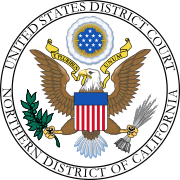Bernstein v. United States
| Bernstein I | |
|---|---|
 | |
| Court | United States District Court for the Northern District of California |
| Full case name | Daniel J. Bernsteinet al., v.United States Department of Stateet al. |
| Decided | April 15, 1996 |
| Citation | 922 F. Supp. 1426 |
| Court membership | |
| Judge sitting | Marilyn Hall Patel |
| Bernstein II | |
|---|---|
 | |
| Court | United States District Court for the Northern District of California |
| Full case name | Daniel J. Bernsteinet al., v.United States Department of Stateet al. |
| Decided | December 9, 1996 |
| Citation | 945 F. Supp. 1279 |
| Court membership | |
| Judge sitting | Marilyn Hall Patel |
| Bernstein III | |
|---|---|
 | |
| Court | United States Court of Appeals for the Ninth Circuit |
| Full case name | Daniel J. Bernsteinet al., v.United States Department of Stateet al. |
| Decided | May 6, 1999 |
| Citation | 176 F.3d 1132 |
| Case history | |
| Prior action | Hon.Marilyn Hall Patelruled for plaintiff in 974 F.Supp. 1288 |
| Court membership | |
| Judges sitting | Betty Binns Fletcher,Myron H. Bright,Thomas G. Nelson |
| Case opinions | |
| Opinion by Fletcher Concurrence by Bright Dissent by Nelson | |
Bernstein v. United Statesis a set of court cases brought byDaniel J. Bernsteinchallenging restrictions on theexport of cryptography from the United States.
History
[edit]The case was first brought in 1995, when Bernstein was a student atUniversity of California, Berkeley,and wanted to publish a paper and associatedsource codeon hisSnuffleencryption system. Bernstein was represented by theElectronic Frontier Foundation,who hired outside lawyerCindy Cohnand also obtainedpro bono publicoassistance from Lee Tien of Berkeley; M. Edward Ross of the San Francisco law firm of Steefel, Levitt & Weiss; James Wheaton and Elizabeth Pritzker of the First Amendment Project in Oakland; and Robert Corn-Revere, Julia Kogan, and Jeremy Miller of the Washington, DC, law firm of Hogan & Hartson. After four years and one regulatory change, theNinth Circuit Court of Appealsruled thatsoftwaresource codewas speech protected by theFirst Amendmentand that the government's regulations preventing its publication were unconstitutional.[1]Regarding those regulations, theEFFstates:
Years before, the government had placed encryption, a method for scrambling messages so they can only be understood by their intended recipients, on theUnited States Munitions List,alongside bombs andflamethrowers,as a weapon to be regulated for national security purposes. Companies and individuals exporting items on the munitions list, including software with encryption capabilities, had to obtain priorState Departmentapproval.
— Electronic Frontier Foundation:EFF's History[2]
The government requesteden bancreview.[3]InBernstein v. U.S. Dept. of Justice,192 F.3d 1308 (9th Cir. 1999), the Ninth Circuit ordered that this case be reheard by theen banccourt, and withdrew the three-judge panel opinion,Bernstein v. U.S. Dept. of Justice,176 F.3d 1132 (9th Cir. 1999).[4]
The government modified the regulations again, substantially loosening them, and Bernstein, now a professor at theUniversity of Illinois at Chicago,challenged them again. This time, he chose to represent himself, although he had no formal legal training. On October 15, 2003, almost nine years after Bernstein first brought the case, the judge dismissed it and asked Bernstein to come back when the government made a "concrete threat".[5]
Recent
[edit]Apple citedBernstein v. USin itsrefusal to hack the San Bernardino shooter's iPhone,saying that they could not be compelled to "speak" (write code).[6]
See also
[edit]References
[edit]- ^"U.S. Court of Appeals for the Ninth Circuit: Bernstein v. USDOJ".Electronic Privacy Information Center.May 6, 1999.RetrievedApril 17,2019.
- ^"EFF's History".Electronic Frontier Foundation.October 7, 2011.RetrievedMay 4,2012.
- ^Bernstein, Daniel J."Summary of the case status".cr.yp.to.RetrievedApril 17,2019.
- ^"192 F. 3d 1308 – Daniel Bernstein v. United States Department of Justice".OpenJurist.F3d(192): 1308. 1999.RetrievedApril 17,2019.
- ^Bernstein, Daniel J."Press Release: Crypto Case on indefinite hold".cr.yp.to.RetrievedApril 17,2019.
- ^Kim Zetter; Brian Barrett."Apple to FBI: You Can't Force Us to Hack the San Bernardino iPhone".Wired.RetrievedJanuary 6,2021.
